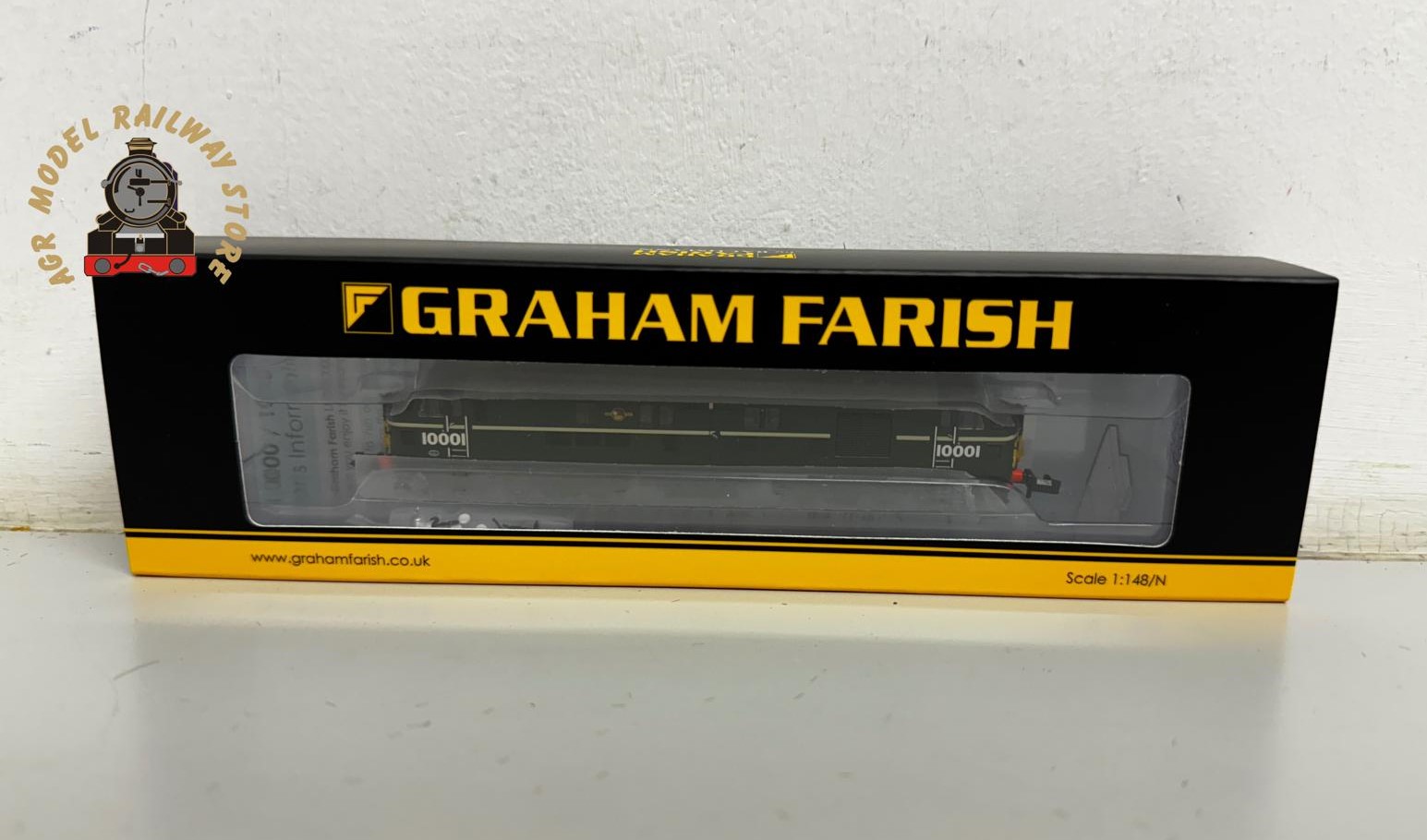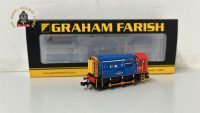Graham Farish 372-918 LMS 10001 BR Green – N Gauge
The LMS ‘Twins’ – Nos. 10000 and 10001 – were the very first mainline diesel locomotives built in the UK and now, this pioneering pair is available in N scale for the first time thanks to Graham Farish.
This model of No. 10001 depicts the second of the ‘Twins’ during its final years in service and makes a perfect addition to any steam/diesel transition fleet. Carrying the eye-catching BR Green livery with Small Yellow Panels, No. 10001 is modelled at a time when its partner was being withdrawn and 10001 was left to soldier on as the last of a unique pair of prototypes, sustained using parts from its twin, 10000.
The Graham Farish model of No. 10001 is a highly detailed masterpiece in miniature, adorned with numerous separately fitted components to accurately capture the appearance of this pioneering machine. The livery application captures the splendour of the prototype, whilst engine room detailing has been replicated through the bodyside windows for the first time. Inside, the proven combination of a coreless motor and twin flywheels, driving both bogies and with all-wheel drive will provide enough power for any prototypical train. The Next18 DCC decoder socket and a pre-fitted speaker make it easy to equip these models for DCC and even add sound, or why not opt for our SOUND FITTED model and enjoy realistic sound effects straight out of the box – whether you’re running on analogue or DCC!
- Graham Farish N Scale
- Era 5
- Pristine BR Green (Small Yellow Panels) livery
- Running No. 10001
- Equipped with a Next18 DCC Decoder Socket
- Length 127mm
DETAIL VARIATIONS SPECIFIC TO THIS MODEL
- Six Headcode Lights & Brackets at each end
- Smooth Bodysides (No Steps)
- Water Scoops Fitted
GRAHAM FARISH LMS 10000 & 10001 SPECIFICATION
MECHANISM:
- Coreless, twin shaft motor with two flywheels providing drive to both bogies
- All axle drive
- Electrical pickup from all wheels
- Separate metal bearings fitted to each axle
- Diecast metal chassis block
- Gearing arranged for prototypical running speeds and haulage capabilities
- 9mm (N gauge) wheels to NEM310 standards with authentic profile and detailing
- Removable coupling pockets to NEM355 standards fitted to each bogie
- Designed to operate on curves of second radius (263.5mm) or greater
DETAILING:
- Bogies constructed from multiple components featuring full relief detail, including separately fitted metal sand pipes
- Separately applied underframe and roof detail components
- Separate lamp irons fitted to each nose
- Detailed cab interior
- Each model supplied with a full set of model-specific bufferbeam pipework and accessory parts
LIGHTING:
- Directional lighting, switchable on/off at either end on DCC or Analogue control
- Passenger/Freight mode, switchable on Analogue control and with additional configurations available when used on DCC
- Cab lighting, switchable on/off (leading end, when used on DCC only)
- Authentic light colours and temperatures selected for each model based on era and application
DCC:
- Next18 DCC decoder interface
SOUND:
- Speaker installed in all models for optimum sound reproduction
- Zimo MS590N18 DCC Sound Decoder fitted to SOUND FITTED versions
- Sound files produced specifically for the Graham Farish LMS 10000/10001 using recordings from real locomotives
- SOUND FITTED models operate on DCC and Analogue control as supplied
LIVERY APPLICATION:
- Authentic liveries applied to all models
- Multiple paint applications employed on each model using BR specification colours
- Logos, numerals and text added as appropriate using multi-stage tampo printing using authentic typefaces, logos and colours
LMS 10000 & 10001 CLASS HISTORY
The LMS ‘Twins’ Nos. 10000 and 10001 were the first mainline diesel locomotives built in Great Britain. A joint venture between the London, Midland & Scottish Railway (LMS) and English Electric, the pair were first conceived in 1946. The body and chassis design was undertaken by the LMS’s Chief Mechanical Engineer H. G. Ivatt, and English Electric provided the engine, electric systems and machinery. Construction of No. 10000 began at Derby Works in 1947 and the locomotive was outshopped in December of that year, days before Nationalisation of Britain’s railways.
Both locomotives entered traffic in an eye-catching black and silver livery, with large chrome numbers fitted at each end of the bodysides, below the cab windows. The letters LMS were also applied in chrome to No. 10000, however No. 10001 did not enter service until mid-1948, with British Railways completing its construction, and so it entered traffic with neither LMS nor BR markings.
The locomotives worked both singularly and as a pair on the Midland Main Line and West Coast Main Line, hauling named expresses and lower key services, and venturing north of the border into Scotland. Interconnecting doors were fitted within the noses of each engine, allowing crew and personnel to move between the two in motion, but this feature was seldom used.
In 1953 the Twins were sent to the Southern Region, being fitted with an additional pair of marker lights and lamp brackets beforehand which made them compatible with the SR’s practice of using headcodes to denote both train types and routes. During a two year period on the Southern Region the Twins worked alongside the Southern’s own diesel prototypes before returning to the Midland Region in 1955.
As prototypes, changes and modifications were made to the locomotives during the years and this included the fitting of water scoops to allow water for the steam heat boiler to be collected from troughs located between the rails ‘on the move’. Ironically, in common with many early diesels, the performance of the steam heat boilers was woeful, and in colder months the pair were often relegated to freight workings where steam heat provision was not required.
By the late-1950s new, production series diesel locomotives were arriving en-masse and whilst their time in service had been highly educational and helped to shape the BR diesel fleet, the writing was on the wall for this pair on non-standard prototypes. No. 10000 was officially withdrawn in December 1963, whilst No. 10001 lasted to March 1966, kept going with components salvaged from its Twin. Sadly, neither was saved and both were subsequently scrapped, but their legacy carried on in the Class 40s, 50s and 56s which all used versions of the English Electric 16SVT engine and today, works is ongoing to build a replica of No. 10000.




